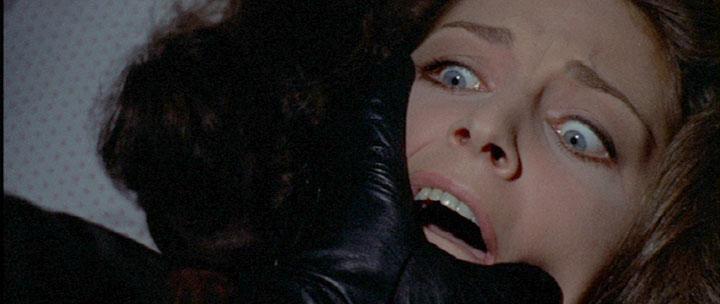
The Bird with the Crystal Plumage (Movie Review)
A young girl enters an old Roman apartment building in the middle of the night. The lobby is empty and the elevator is broken. She starts cautiously up the stairs and the lights go out. She continues onward with only the glow from her cigarette lighter to guide her through the darkness. At the top of the stairs a killer lies in wait… Not the most original sounding set up for a kill sequence. However, any material in the hands of Dario Argento is bound to come out sideways, backwards or upside down and it will inevitably be much more interesting than a simple synopsis would suggest.
“The Bird with The Crystal Plumage” is Dario Argento’s 1969 directorial debut and a watershed moment for the Giallo as a film cycle. But just as the summary above suggests, the genius is not in the story so much as the execution.
Sam Dalmas is a writer at the end of a long stint in Rome. During his time there he penned a book on ornithology but never found the inspiration to write the great novel he had hoped would emerge from a trip to the eternal city. One night during a walk home, Sam witnesses a woman being stabbed in an art gallery. He manages to chase off the would-be killer and summon the police. The woman Monica Ranieri survives but the killer escapes and Sam is drawn into a dangerous game of cat and mouse, or cat and bird in this case.
Inspector Morisini heads up an investigation which manages to put almost everyone in harms way as the killer’s reign of terror broadens. Sam and his girlfriend Julia are used as pawns and very nearly killed on more than one occasion. Gradually, clues begin to emerge; a strange sound in the background of one of the killer’s phone calls, a bizarre painting of a woman being mauled in a field, and a pimp named ‘So Long’ push Sam and the Inspector to the brink of discovering the killer’s identity.
“The Bird with The Crystal Plumage” is a seminal event in the history of the Giallo. It is not, in my opinion, Argento’s best contribution to the “yellow” film tradition but it does reconfigure the attributes of the Giallo. The film moves away from Mario Bava’s austerity and psychedelic forays to create a unique vision that relies more on visceral thrill than psychological deconstruction. Not that there isn’t some pop psychology trotted out here and there but for the most part explaining the motive takes a back seat to the mystery and atmosphere. It is not about putting style over substance but it does place the two on equal footing.
There are a number of things that make this film standout above it’s predecessors in the genre. The first is Ennio Morricone. The man who changed the face of film music with his wild scores for the Sergio Leone westerns once again proves his range and inventiveness. Morricone’s score for "Bird" is nearly perfect. The music is accompaniment, antagonist, and internal reflection. In performing so many functions the score exquisitely mirrors Argento’s multiple perspective style of storytelling.
Another secret weapon is cinematographer Vittorio Storaro. (Okay, at this point the man is no secret having lensed “Apocalypse Now”, "The Conformist”, and “The Last Tango in Paris”, to name a few.) The camera work may be the single most defining feature of “The Bird with The Crystal Plumage”. Throughout the film the battery of DP and Director make bold and difficult choices that keep the audience off balance as the story unfolds.
Storaro and Argento obviously spent a lot of time storyboarding and framing their shots. But what makes this so revolutionary is that the immaculate and often classical compositions are broken up by a spirit of joyous experimentation. Ping pong POVs during murder scenes are preceded by dizzying shots of spinning geometric staircases. The liberal use of the killer’s perspective is chased by Hitchcockian addition by subtraction, and just for good measure the camera is launched out of a sixth story window. Of course, what makes all this innovation work is the return to baseline. This isn’t “Suspira” or “Inferno” where we are completely submerged in an isolating alternate universe that justifies any and all weirdness. "Bird" deftly and compellingly transports us through late sixties Rome, detours into frenzied kill-space and returns us to the recognizable world without a misstep.
As I said before, I don’t think this is Argento’s best Giallo. The main reason is that compared to efforts like “Deep Red” and “Tenebrae” “The Bird with The Crystal Plumage” is underdeveloped in a couple of key ways. The narrative while plausible is not as involving as the aforementioned films. The acting is none too memorable with the exception of the bit players who give the film its comic flourishes. But even these potentially major issues are minor complaints when one considers the whole of the picture.
“The Bird with The Crystal Plumage” is a landmark film. It signaled the birth of a strong and resounding voice in world cinema. It also transformed the Giallo from an Italian cultural footnote into a film movement that would grow in popularity over the next four decades even as the number of films dwindled. "Bird" is a mystery engineered like a horror film and rendered as art. Perhaps the most impressive aspect of the film is that at the age of 40 it is still kinetic, vibrant and vigorous.

